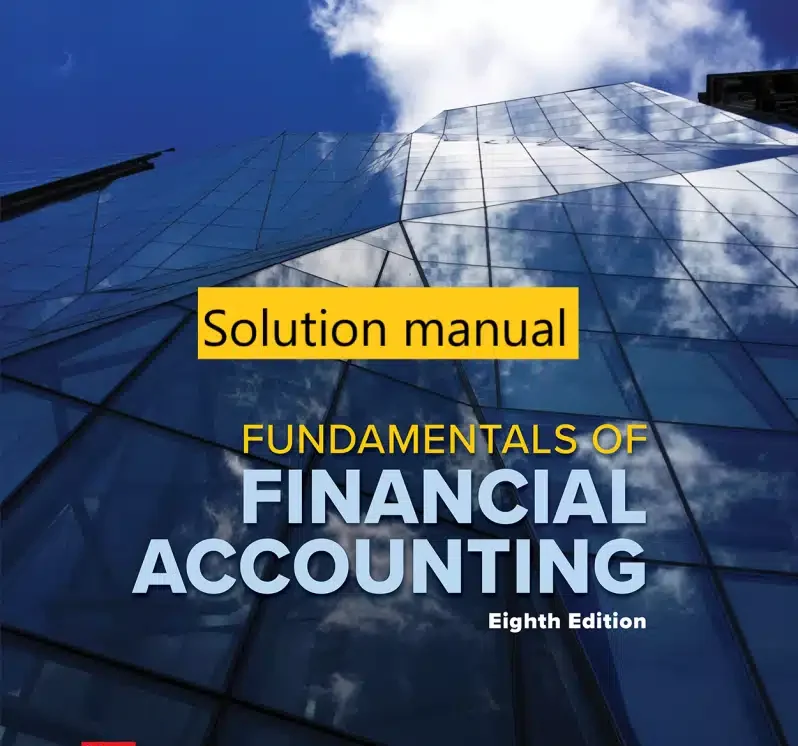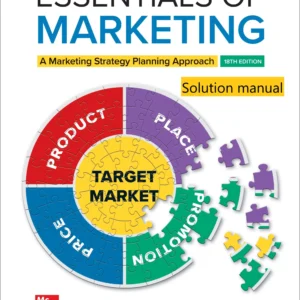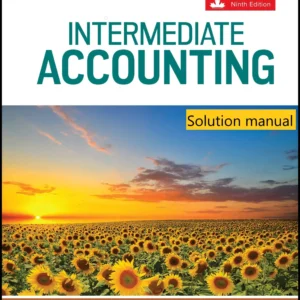Original price was: $39.99.$24.99Current price is: $24.99.
Solution manual for Fundamentals of Financial Accounting 8th Edition By Fred Phillips
Product ID: 1020200
For Contact: bookzon.shop@gmail.com
Description
Solution Manual for Fundamentals of Financial Accounting, 8th Edition
By Fred Phillips
Book Overview
The 8th Edition of Fundamentals of Financial Accounting by Fred Phillips is a comprehensive solution manual designed to facilitate student learning and instructor engagement. This edition offers an approachable, easy-to-follow format that breaks down complex accounting principles into digestible concepts. The text presents real company stories, interactive videos, and simplified data analytics exercises, all of which guide students through the core concepts of financial accounting. These unique resources help students connect business decisions with their financial implications.
A significant feature of this edition is its structured approach to the accounting cycle, providing a smooth learning curve that mirrors the decision-making process entrepreneurs face when starting a business. In addition, the manual includes numerous assignments such as coached problems and data analytics exercises, enabling students to apply their knowledge in real-world contexts.
The Connect resources—including Tableau Dashboard Activities, integrated Excel tasks, and SmartBook—further enrich the learning experience, offering interactive content that enhances understanding and application of financial accounting concepts.
Table of Contents
1. Business Decisions and Financial Accounting
This chapter introduces students to the role of financial accounting in business decisions. It explains how fundamental accounting practices directly influence financial results, providing a basis for sound decision-making in business operations.
2. The Balance Sheet
This section covers the structure of the balance sheet, including assets, liabilities, and stockholders’ equity. Students learn how to prepare and interpret balance sheets to assess a company’s financial position.
3. The Income Statement
Focusing on the income statement, this chapter explains how revenues and expenses are recorded and classified. Students will understand how to calculate and evaluate profits and losses over a specified period.
4. Adjustments, Financial Statements, and Financial Results
Here, students are introduced to the process of making adjustments in financial reporting, and how these adjustments affect the final financial statements and overall financial results.
5. Fraud, Internal Control, and Cash
This section emphasizes the importance of internal controls in preventing fraud and managing cash flow. It helps students understand how these controls protect businesses from financial mismanagement.
6. Merchandising Operations and the Multistep Income Statement
Students explore merchandising operations and learn how to prepare a multistep income statement, which provides detailed insights into a company’s operations and profitability.
7. Inventory and Cost of Goods Sold
This chapter delves into inventory management and how businesses calculate Cost of Goods Sold (COGS). Students will learn how inventory affects financial statements and how to assess a company’s inventory turnover.
8. Receivables, Bad Debt Expense, and Interest Revenue
The focus here is on accounts receivable, bad debt expense, and interest revenue. This chapter teaches students how to account for receivables and how to handle bad debts and revenue recognition.
9. Long-Lived Tangible and Intangible Assets
This chapter covers how businesses account for long-lived tangible assets (e.g., property and equipment) and intangible assets (such as patents or trademarks). Students will learn about depreciation and amortization and their impact on financial statements.
10. Liabilities
Students are introduced to the concept of liabilities, including current and long-term liabilities. The chapter explores how businesses manage and report their debts and obligations.
11. Stockholders’ Equity
This chapter explains the components of stockholders’ equity, including common stock, retained earnings, and how equity financing impacts a company’s capital structure.
12. Statement of Cash Flows
A comprehensive guide to the statement of cash flows, this section explains the three main types of cash flows—operating, investing, and financing—and how they affect a company’s liquidity.
13. Measuring and Evaluating Financial Performance
Students learn to use various financial ratios and performance metrics to evaluate a company’s financial performance. This includes analyzing profitability, liquidity, and solvency.
Appendices
-
Appendix A: Excerpts from the Fiscal 2021 10-K Annual Report of The Home Depot, Inc.
Real-world application of accounting principles using excerpts from The Home Depot’s 10-K annual report, allowing students to see how these concepts are applied in a large corporation. -
Appendix B: Excerpts from the Fiscal 2021 10-K Annual Report of Lowe’s Companies, Inc.
Additional real-world examples from Lowe’s 10-K report to further illustrate financial reporting and the practical application of accounting theory. -
Appendix C: Present and Future Value Concepts
Introduces the core principles of time value of money (TVM), including present value and future value concepts, which are essential for evaluating investment opportunities and financial decision-making. -
Appendix D: (Available in Connect) Investments in Other Corporations
Covers how to account for investments in other corporations, with additional content available through the Connect platform to reinforce learning and provide hands-on practice.
For more manual solutions, click here.






Excellent digital version
Great for revision
Great choice
Saves effort
Excellent mock test